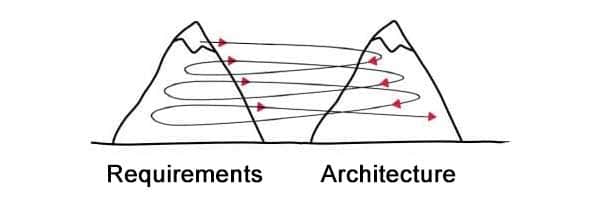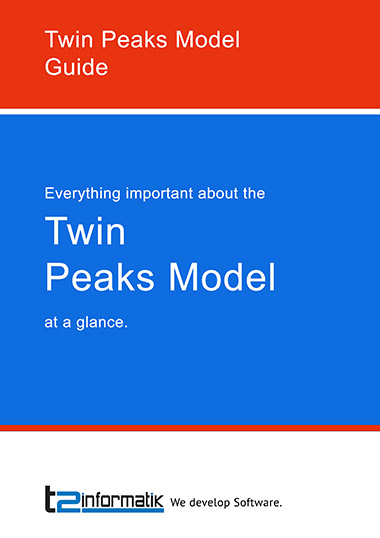What is the Twin Peaks Model?
Tabe of Contents: Definition – Parallel development – Communication – Questions from the field – Download – Notes
Smartpedia: The Twin Peaks Model describes the concretisation of requirements in parallel with the exploration of suitable system architectures.
Twin Peaks Model Definition
The Twin Peaks Model describes how you develop the requirements and architecture of a system iteratively and in parallel. It provides the answer to the question “What needs to be developed first – the requirements or the architecture”. It illustrates the related activities of requirements engineering and system architecture development.
Define requirements or design software architecture first?
Many IT organisations are faced with the question of how they should proceed when developing a new system. Is it a question of capturing requirements first or would it be better to design the software architecture first? Requirements can change, new technologies can appear and earlier design decisions can be questioned. It is therefore advisable at the beginning to design the most important requirements for a system rudimentarily. Use these requirements to develop a prototype or Minimum Viable Product (MVP), get stakeholder feedback, and revise your design. Derive new requirements and reassess and prioritize existing requirements. And implement the prioritised requirements in the architecture again.
Communication during parallel development
The Twin Peaks Model describes a dynamic interaction between requirements and architecture. Good communication between the project participants is essential for this interaction. Ideally, the project team should include both a requirements analyst and a system architect. Both work simultaneously and iteratively. On the one hand, problems with architectural limitations are better understood and on the other hand, architectures are better developed or adapted on the basis of requirements. Of course, the system architect needs an excellent overview of the system and its environment. He assesses the effects and dependencies of requirements on the architecture and communicates requirements resulting from different architectural alternatives.
Advantages of parallel development
Requirements and the architecture of a system are strongly interdependent. The Twin Peaks Model pursues the idea of paying attention to requirements and architecture in parallel. This results in various advantages:
- The detailing and concretisation of requirements takes place just as step by step as the exploration of suitable architectural alternatives. Thus the architecture grows on the basis of the requirements and architectural decisions can lead to concretisation and re-evaluation of requirements.
The architecture is the focus and can be designed in such a way that both the set goals and functional and non-functional requirements are fulfilled. At the same time an Architecture-Indifferent Design with a neglect of the architecture is avoided, with which developers use existing or in the domain usual architectures (Presumptive Architecture). - Project and product risks can be reduced by evaluating alternatives through analysis, simulation, prototyping or refactoring.
- Traceability is increased because architectural decisions can be traced back to requirements and vice versa.
- Inconsistencies between requirements and architecture are avoided.
- Critical requirements are easily overlooked without early architecture evaluation. This often leads to reworking, delayed design changes and high costs. This can be avoided with the Twin Peaks model.
Questions from the field
Here are some questions and answers from the field:
Where did the Twin Peaks Model come from?
The Twin Peaks Model is a simplified version of the Spiral Model and goes back to Professor Bashar Nuseibeh, who argued in 2001 that the requirements analysis and the architectural design should be interlocked and organised in parallel. He had recognised that a sequential order of “Requirements first, Design second” is not appropriate for innovative systems.
Where does the name of the Twin Peaks Model come from?
The Twin Peaks model is visualised with two similar mountains (therefore called Twin Peaks); one mountain represents the requirements, the other the architecture. Both are equally high and equally important. They start with rough requirements and architectural models and refine them parallel to each other in mutual alternation. In this way, from the narrow summit of the mountains, you will arrive at new requirements and architectural elements with increasing detail.
Which questions help to keep the architecture in view during the course of a development?
- Which software architectures are stable with changing requirements and how do we select them?
- Which requirements are more stable than others and how do we identify them?
- Which requirements are volatile and how do we identify them?
- How can systems be scaled for the future?
- How do I achieve modularisation of systems?
Notes:
If you like the article or would like to discuss it, please feel free to share it in your network. And if you have any comments, please do not hesitate to send us a message.
Here you can find additional information from our t2informatik Blog:




